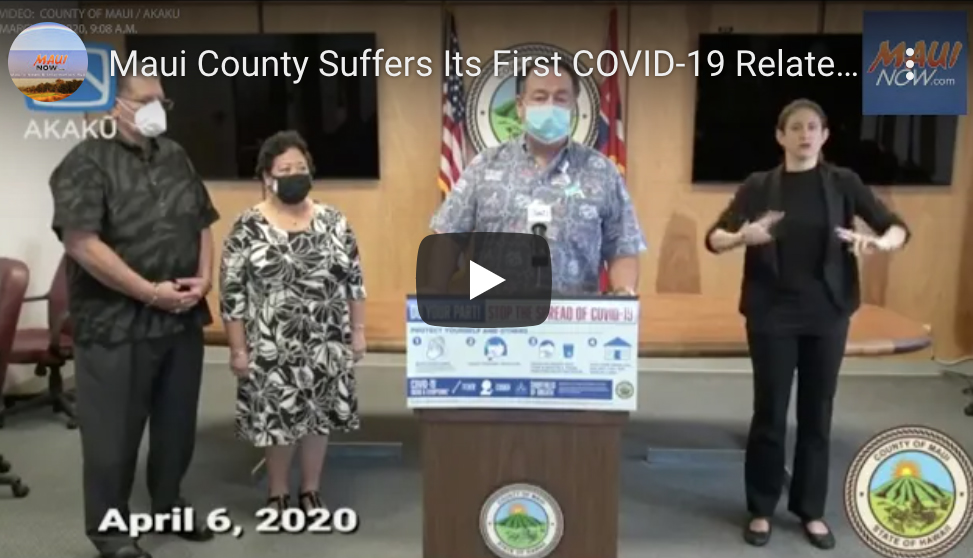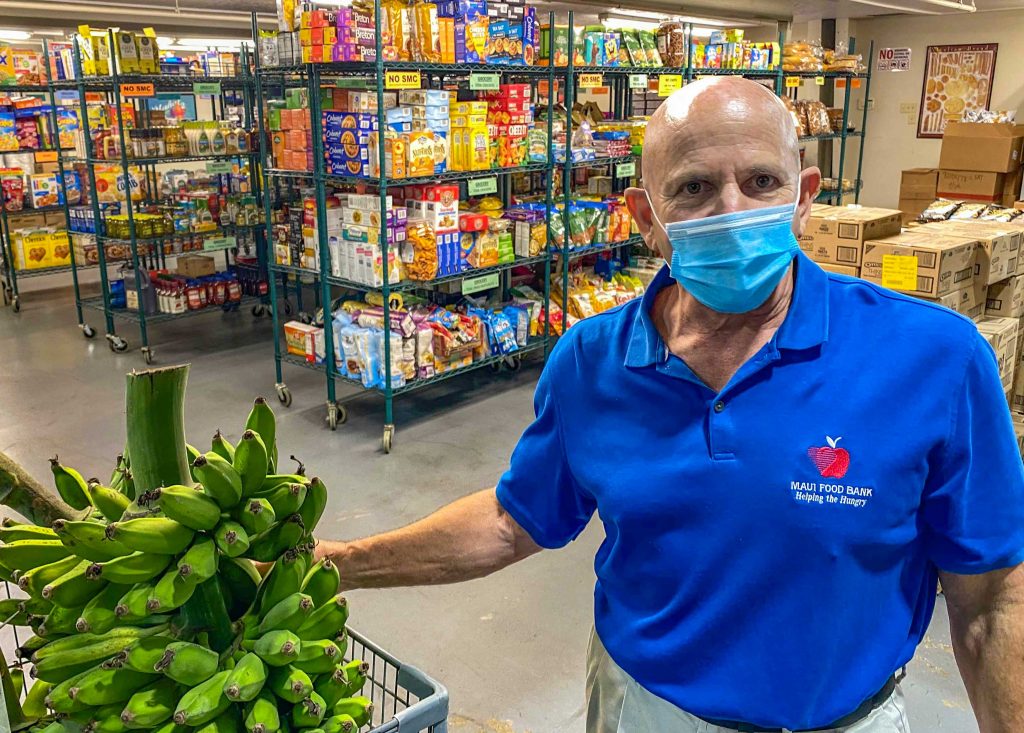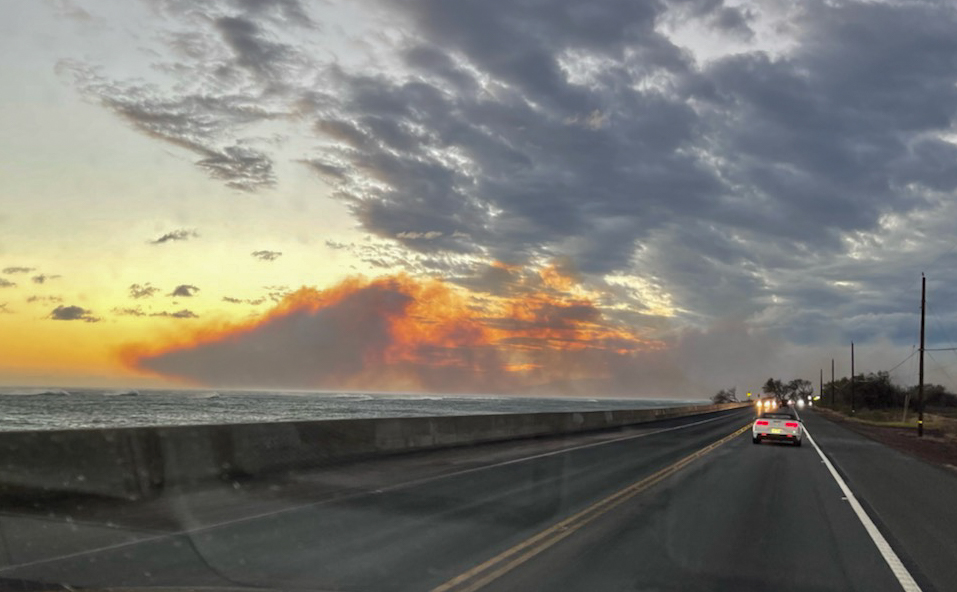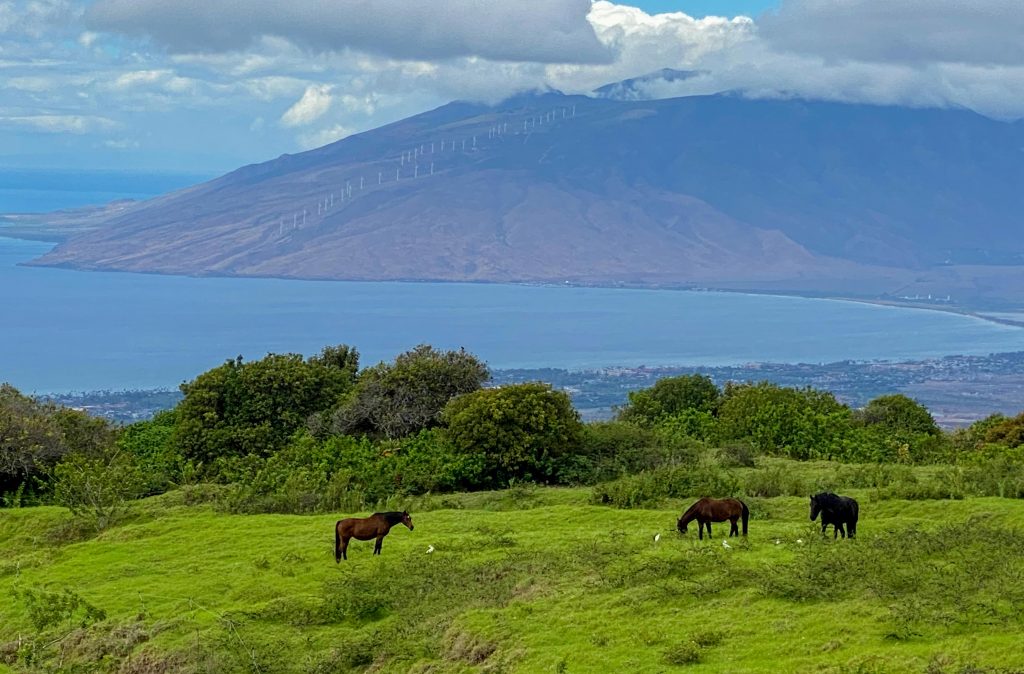Maui 2020 in Review: Goodbye Tourists, Hello Masks & Social Distancing
As 2020 comes to an end — hallelujah! — Maui Now takes a look back at the year like no other, when masks became fashion items, Old Lahaina became a ghost town and Maui lost an icon, Willie K.
It seems like a lifetime ago when Maui rang in the arrival of 2020 with 35-foot surf on the north shores and fireworks from the Grand Wailea and Four Seasons resorts. The economy was booming. Tourism was at a record high. Unemployment was among the lowest in the country at less than 3 percent. And Hall and Oates had just announced a March 29 date to play at the Maui Arts and Cultural Center.
In January, the two “big” stories were a protest/counter protest over transgender inclusion in front of Maui High School that was started by two members of the Kansas-based Westboro Baptist Church – and a Kīhei man who took his kids up on a dare and stood in line for 16 hours to be first in line for the grand opening of a popular Philippines fast-food restaurant Jollibee, “Home of the Famous Chickenjoy.”
But by February, there was a hint that 2020 would not be a normal year, and it was not because snow fell on Haleakalā. On Valentine’s Day, the Hawaiʻi Department of Health held a press conference to announce a Japanese citizen, who recently was on Maui and Oʻahu, had tested positive for the COVID-19 novel coronavirus upon his return to Japan.
“I know this raises a concern for all of us,” Hawaiʻi Gov. David Ige said.
At the time, few knew how big a concern. There were only 15 positive cases of COVID-19 in the United States, and none confirmed in Hawaiʻi.
But just three weeks later, Hawaiʻi had its first confirmed case of COVID-19 from a returning resident who flew to Honolulu after spending time on the Grand Princess cruise ship that traveled to Mexico in February. A passenger on the same cruise in Mexico died from the new disease. At this point, 90 people were under self-quarantine in Hawaiʻi, most identified through screening by federal officials at the Honolulu airport. Soon, no cruise ships would be allowed to port in Hawaiʻi.
On March 14, Maui Now posted COVID-19: List of What’s Canceled, Closed or Postponed on Maui. The list was long. It included government offices, public schools, community events, youth centers, Haleakalā National Park, the Diana Ross concert, the Maui Arts & Cultural Center and many businesses big and small, including the Old Lahaina Lūʻau and the Maui Ocean Center.
Hall and Oates’ concert also was postponed. The duo’s hit song could have been Maui’s mantra: “Say it isn’t so.”
On March 18, Maui County Mayor Michael Victorino announced several Public Health Emergency Rules that would go into effect March 20. They included closures of bars, nightclubs, theaters and venues with large gatherings.
“We need to take dramatic action to limit the spread of this infectious virus,” Mayor Victorino said.
Within a week, the action would be even more dramatic. Maui County updated its emergency rules and ordered people to stay at home and work from home, effective March 25 to April 30.
“Everyone will still be able to get groceries and other essential products,” Mayor Victorino said. “Essential businesses will also still be able to continue.” But at this time it was good luck finding hand sanitizer or toilet paper.
On March 21, Gov. Ige issued a mandatory 14-day quarantine for everyone arriving in Hawaiʻi. It went into effect March 26. There were a few exceptions, including emergency responders and those with critical infrastructure functions.
Tourism came to a crashing halt. Old Lahaina became a ghost town. Traffic was virtually non-existent on the road to Hāna. And Maui’s waters were packed — with recently unemployed and furloughed locals.
On April 6, the Hawai‘i Department of Health confirmed the first COVID-19 related death in Maui County. It was a man over 65 years of age and with underlying conditions. He was the fifth person to die from the disease in Hawaiʻi.
“My heart is heavy with this tragic news,” Mayor Victorino said. “Mrs. Victorino and I offer our deepest condolences to this individual’s family and know that our community will also offer support and love during this difficult time.”
At that point, there were 387 cases of COVID-19 identified in Hawaiʻi with 7 percent of the cases requiring hospitalization and with more than 80 percent of the cases from residents returning to the state.
People learned quickly the 14-day quarantine mandate would be enforced. On April 8, 20 Hawaiʻi National Guard Personnel were on Maui assisting airport personnel in screening arriving passengers. Two California residents who arrived with no destination on Maui were given a choice: be arrested or go home. Both decided to return to California.
“One of them actually said that they were headed to the homeless resource center,” Victorino said.
In mid-April, “permanent” checkpoints for Hāna were established to ensure only residents could go to Hāna. State rules that many thought were draconian were also added that prevented running and walking on beaches.
In May, the news kept getting worse. Hawaiian music icon Willie K died after a long battle with lung cancer. The beloved musician and man was just 59. He passed away in his home in Wailuku, surrounded by his ʻohana.
The popular Hawaiian entertainer Uncle Willie K, born Willie Kahaialiʻi of Lahaina, was diagnosed with small cell carcinoma lung cancer in January of 2018. He played at New Yearʻs Eve 2019 at Mulligans on the Blue and at his annual Willie K & Friends 2020 Bluesfest on Jan. 4. In January, he announced his cancer diagnosis was terminal, but vowed to keep “rocking.”
“He was in positive spirits and doing okay, and he was looking forward to performing again,” a message to his fans said. “He then suddenly turned for the worse and lost his battle.”
In late June, there was some good news with Gov. Ige announcing a pre-travel testing program that would allow visitors and residents flying to Hawaiʻi to skip the 14-day mandatory quarantine with a negative COVID-19 test taken within 72 hours of traveling. It originally was scheduled to launch Aug. 1. But all did not go according to plan and the program was delayed several times while many businesses and unemployed individuals struggled to survive.
Also in June, the state Department of Labor and Industrial Relations detected $15.8 million of potentially fraudulent claims paid out as of June 24. In addition, the department reportedly blocked $76.6 million in “possible fraudulent Pandemic Unemployment Assistance payments.” At that time, nearly 6,000 victims reported Identity theft after receiving a letter about eligibility for PUA benefits.
“Unfortunately, bad actors including organized crime continue to attack the program designed to support ourvulnerable residents during the COVID-19 Pandemic,” Deputy Director Anne Perreira-Eustaquio said.
Along came July and the threat of Hurricane Douglas. Maui residents scrambled to prepare for the storm, with the recycling centers busier than usual. At one point, Maui County was upgraded from a Hurricane Watch to a Hurricane Warning by the Central Pacific Hurricane Center with the system maintaining its Category 1 strength with 90 mph sustained winds and higher gusts. But Maui was spared the worst of the strong winds, storm surge and flooding, with Hurricane Douglas coming within “razor thin” distance of the Hawaiian islands.
On July 28, a Special Agent with the Bureau of Alcohol, Tobacco, Firearms and Explosives, John Bost III, died from a wound received from an accidental discharge of a rifle while on duty at the Maui Police Department’s Kīhei Division Office, where he was employed with ATF. The North Carolina native had worked in Maui since 2015.
In August, with the mandatory quarantine still in full swing, Maui County confirms filming of Temptation Island, a reality television show that is not about social distancing, will begin at the Andaz Maui at Wailea Resort. The premise of the show is several couples agree to live with a group of singles of the opposite sex, in order to test the strength of their relationships.
“I’m not too keen about it,” Mayor Victorino said. “In fact, I’m not very happy about it, but it’s been approved on the state level.”
After public outcry about COVID-19 health and safety concerns, Temptation Island production was delayed. But ultimately it was allowed to film, including a biking scene on the grounds of the Kula Botanical Garden.
But some love and hanky panky was not allowed. In early September, the “Love Has Won” cult was intercepted at Kahului Airport when airport screeners discovered that three of its members, including leader Amy Carlson, had reservations at a Maui location not approved for quarantine. Hours later they were on a flight headed to San Francisco with a connection to the cult’s home base of Colorado. Another 11 members of Love Has Won also were traveling from Kauaʻi to Maui, but they were stopped on Oʻahu and diverted to Colorado.
During the cult’s more than month stay in a luxury beachfront rental on Kauaʻi there were several protects, vandalism and small fires reported. The cult describes itself as believing in Lemuria, a mythical lost continent whose contemporary followers believe Lemurian descendants may still reside within Mt. Shasta. As the protests in Kauaʻi escalated, the group decided to head to Maui for its safety.
By mid September, Hawaiʻi’s Safe Travel Program still had not launched. Old Lahaina was still a ghost town, with more than 120 businesses along Front Street closed for six months and counting.
More than 15 businesses all across Maui, including eight restaurants, already had shuttered for good due to the economic woes of the pandemic. Valley Isle Seafood’s last Facebook post said: “I wish RIP meant Return If Possible.” Jini’s Fijian Curry in Wailuku closed in July after seven years in business. And Josh Curi, owner of Da Babooze Bar in Wailuku, said: “We are literally hanging on by our fingertips.”
Pamela Tumpap, president and executive board member of the Maui Chamber of Commerced said: “We once thought the direct and indirect trickle down from the visitor industry was about 75 percent. We now know it is much higher than that, and likely 85 to 90 percent.”
But help was on the way. Finally, Hawaiʻi’s Safe Travel Program launched on Oct. 15 with Mayor Victorino calling it the “rebirth of our visitor industry.” United Airlines Flight 417 from Los Angeles was Maui’s first arriving plane from the mainland under the new program. On board were 137 people.
The quarantine had played a large role in keeping COVID-19 cases relatively low in Maui County. At the time there were 409 confirmed cases, with 17 deaths. The quarantine also played a large role in job losses, leading to one of the country’s highest unemployment rates for a county at 20.7 percent.
The launch of the Safe Travel Program was celebrated with the trio of Joel Katz, Kalena Foster and Kahala Greig, who usually perform at the still-closed Old Lahaina Lūʻau, playing Hawaiian music in the baggage claim area. A kahu also conducted a much-needed blessing.
The return of tourism, even at a trickle of what it was before the pandemic, was welcome news to some who have struggled for the basics.
In mid-March, food distribution sites began springing up due to the need and by September there were more than 30 locations around the island, and on Molokaʻi and Lānaʻi.
“There’s been so much hardship because of the pandemic,” Ulu Nahooikaika of Olawalu said after loading several bags of fresh produce, organic spaghetti and other items at the Feed My Sheep Maui location in Lahaina. “I lost my job as an entertainment performer. I’m behind on a lot of my bills. I say thank you for helping us out.”
Keith Wright, Maui Food Bank’s Director or Operations, said: “We’ve gone from serving roughly 10,000 people a month to almost 40,000. It used to be mostly for individuals. Now it’s families.”
Creativity was key to the savior of some Maui businesses, including the Surfing Goat Dairy in Kula. It was able to reopen its doors thanks to a successful “GOat Fund Me” campaign in which 50 of its 100 goats, including Chili Chicken, Maybelline and Edelweiss, were “adopted.”
In October, along came a cluster of mysterious lights in the Maui sky to distract our attention from the pandemic. There were many theories to its origin. But John O’Meara, Chief Scientist at W.M. Keck Observatory near the summit of Mauna Kea, said the lights likely were from an old rocket booster that launched a Venezuelan communications satellite into space in China in 2008.
“That booster has been orbiting around the Earth, but its orbit has been decaying and eventually decayed enough to get slowed down by the atmosphere and reentered in over the Pacific,” O’Mear said in a Zoom interview with Maui Now’s Wendy Osher. “So as it does, it falls into the atmosphere, it starts to break apart and heat up, and so it makes a nice twinkly light show as it falls apart. … Without many other folks around in the Pacific, we’re probably the only place on the planet that got to see it with our eyes.”
Back to Earth, along comes the much-awaited Nov. 3 election. Maui had a higher than usual voter turnout with 71,653 people (66.4 percent) casting ballots. This included 67,096 that voted by mail and 4,557 who voted in-person. The Maui election results included yes to a Maui County charter amendment to create a new agriculture department.
In a two-week period in late October and early November, Maui Police cracked down on mask-wearing enforcement, issuing 264 citations for face mask violations (209 residents, 55 visitors).
For the week ending Nov. 7, Maui County has had an 85 percent mask wearing compliance rate, with 6 percent wearing their mask incorrectly and 9 percent with no mask. The goal is 100 percent compliance.
Maui County received $67 million in federal CARES Act funding to deal with the pandemic. Some of that stimulus went to put unemployed people back to work on projects that benefited the island. They included unclogging the Kalepa Gulch for better water flow at the Waiheʻe Coastal Dunes and Wetlands Refuge.
“This federal funding is a silver lining of the pandemic,” said Scott Fisher, the Hawaiian Islands Land Trust’s chief conservation officer. “We are able to get critical work done in a number of areas of the refuge that will have long lasting, generational impacts on both our understanding of the life of the land and our ability to restore and heal this land.”
December rolled in and so did the first big surf of the season. At Peʻahi surf break known as Jaws, 20- to 30-foot waves created by faraway large winter storms drew big wave riders including local star Kai Lenny and people who just wanted to watch the action.
“Itʻs a big thing every year, the Haʻikū boys come down here and get muddy,” said Zach Waddell, who was with his brother Joshua. “I surf, but not these ones.”
But December also brought a tragedy on the water. Robin Warren, 56, of Nāpili died from injuries sustained during a shark attack at Honolua Bay just before the second day of the Maui Women’s Pro Surf competition was set to get underway. Warren was about 20 yards offshore during an early morning surf session when the shark, which later was identified by researchers as a tiger shark about 14.3 feet long, bit him and took a large chunk out of his surfboard. The surf competition was cancelled at the site.
Just three weeks earlier, a 35-year-old California woman was bitten by a shark about 100 yards offshore from the Mahina Surf Condominiums in Lahaina, but she survived her wounds.
On a bright spot, Maui and much of the world was treated to the Geminids meteor shower in mid-December and the “Christmas Star,” whose peak was Dec. 21. The “Christmas Star” was the great conjunction of Jupiter and Saturn, which had not appeared this close since 1623 when Galileo was alive. But that time the glare of the sun and low altitude above the horizon made the astronomical event hard to see.
So for skywatchers, the last observable time these two planets were this close — creating almost a single bright star — was nearly 800 years ago on March 5, 1226.
The bad news for 2020 wasn’t quite over yet. The day after Christmas a brush fire broke out in Olowalu and spread quickly with high winds. The blaze burned about 760 acres, caused the evacuation of several residents, closed Honoapiʻilani Highway for hours and destroyed a historic church that also served as a community hall, as well as two storage units and two vehicles.
Since March, Maui residents have made great sacrifices to keep each other safe. While the pandemic is out of control in much of the country, Maui’s COVID-19 cases have remained relatively low at 1,086 (958 on Maui, 106 on Lānaʻi and 22 on Molokaʻi), even with the reopening of tourism on Oct. 15 with the Safe Travel Program.
And while COVID-19 deaths have spiked, too, Maui has not had one COVID-19 related death since September. Maui County has had 17 COVID-19 related deaths during the first six months of the pandemic. To date, 73 people have required hospitalization.
Many people have worked tirelessly to help people in need in the county, including many volunteers who routinely man the food distribution sites.
Some Maui healthcare workers and nursing home residents have received the first doses of the COVID-19 vaccine, but the pandemic is not over. To continue to keep cases as low as possible, the County has just issued new rules to limit the size of gatherings and further limit occupancy and closing times at bars and restaurants.
And more help is on the way for struggling business owners and individuals. Congress recently signed a new COVID-19 relief package.
But through it all, Maui’s beauty has continued to provide hope — as has the aloha of the people who call this island home.
As 2020 comes to a close, may the new year bring hope, health and happiness to all. And dare we say: “Happy 2021!”
Maui Now News Director Wendy Osher contributed to this report.



















































